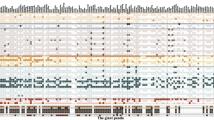Abstract
The antimicrobial resistance of 1,018 isolates of Enterobacteriaceae isolated from fecal specimens of the urban population of Riyadh, Saudi Arabia, was studied. Resistance to 1 or more of 10 antimicrobial agents was encountered in 50.2% of the isolates. Of the isolates tested,Escherichia coli (0.8%) andKlebsiella species (1.6%) were found resistant to seven antimicrobial agents simultaneously: ampicillin, chloramphenicol, kanamycin, colistin, streptomycin, tetracycline, and carbenicillin. Resistance to nalidixic acid was encountered in only 0.68% of theE. coli isolates. No isolate was found to be resistant to gentamicin. Eighty-six of the resistant strains were tested for their ability to transfer their resistance. Forty percent were able to do so withE. coli K-12.
Similar content being viewed by others
Literature Cited
Al-Sowaygh, I. A. 1971. Piliation and fertility of enteric bacteria carrying R and F factors. Ph.D. thesis. University of Southampton.
Anderson, E. S. 1968. The ecology of transferable drug resistance in the enterobacteria. Annual Review of Microbiology22:131–152.
Bauer, A. W., Kirby, W. M. M., Sherris, J. C., Turck, M. 1966. Antibiotic susceptibility testing by a standardized single disk method. American Journal of Clinical Pathology45:493–496.
Byers, P. A., Dupont, H. L., Goldschmidt, M. C. 1976. Antimicrobial susceptibilities of shigellae isolated in Houston, Texas, in 1974. Antimicrobial Agents and Chemotherapy9:288–291.
Chun, D., Seol, S. Y., Cho, D. T., Tak, R. 1977. Drug resistance and R plasmids inSalmonella typhi isolated in Korea. Antimicrobial Agents and Chemotherapy11:209–213.
Datta, N. 1973. Transmissible antibiotic resistance, pp. 31–40. In: Geddes, A. M., Williams, J. D. (eds.), Current antibiotic therapy. Edinburgh, London: Churchill Livingstone.
Davis, C. E., Anandan, J. 1970. The evaluation of R-factor: A study of a pre-antibiotic community in Borneo. New England Journal of Medicine282:117–119.
Falkow, S. 1975. Infectious multiple drug resistance. London: Pion.
Farrar, W. E., Edison, M. 1971. Antibiotic resistance inShigella mediated by R-factors. Journal of Infectious Diseases123:477–501.
Guinée, P., Ugueto, N., van Leeuwen, N. 1970.Escherichia coli with resistance factors in vegetarians, babies and non-vegetarians. Applied Microbiology20:531–536.
Hocmanová, M., Krčméry, V. 1974. Occurrence of a seven-drug-resistance plasmid in two strains ofSalmonella typhimurium from diarrheatic patients. Zentralblatt für Bakteriologie, Parasitenkunde, Infektionskrankheiten und Hygiene, Abt. 1 Orig., Reihe A229:277–278.
Laufs, R., Kleimann, F. 1978. Antibiotic resistance factors and other plasmids in bacterial isolates from hospitalized patients. Zentralblatt für Bakteriologie, Parasitenkunde, Infektionskrankheiten und Hygiene, Abt. 1 Orig., Reihe A240:503–516.
Mare, I. J. 1968. Incidence of R-factors among gram-negative bacteria in drug-free human and animal communities. Nature220:1046–1047.
Mitsuhashi, S. 1977. R-factor: Drug resistance plasmid. Baltimore, London, Tokyo: University Park Press.
Neu, H. C., Cherubin, C. E., Longo, E. D., Winter, J. 1975. Antimicrobial resistance of Shigella isolated in New York City in 1973. Antimicrobial Agents and Chemotherapy7:833–835.
Rennie, R. P., Duncan, I. B. R. 1977. Emergence of gentamicin-resistantKlebsiella in a general hospital. Antimicrobial Agents and Chemotherapy11:179–184.
Richmond, M. H. 1975. R factors in man and his environment, pp. 27–35. In: Schlessinger, D. (ed.), Microbiology—1974. Washington, D. C.: American Society for Microbiology.
Slocombe, B., Sutherland, R. 1973. Transferable antibiotic resistance in enteropathogenicEscherichia coli between 1948 and 1968. Antimicrobial Agents and Chemotherapy4:459–466.
Tanaka, T., Tsunoda, M., Mitsuhashi, S. 1975. Drug resistance inShigella strains isolated in Japan from 1965 to 1973, pp. 187–199. In: Mitsuhashi, S., Hashimoto, H. (eds.), Microbial drug resistance. Baltimore, London, Tokyo: University Park Press.
Watanabe, T. 1963. Infective heredity of multiple drug resistance in bacteria. Bacteriological Reviews27:87–115.
Watanabe, T. 1971. Infectious drug resistance in bacteria. Current Topics in Microbiology and Immunology56:43–98.
Author information
Authors and Affiliations
Rights and permissions
About this article
Cite this article
Al-Sowaygh, I.A., Shibl, A.M. Incidence of antimicrobial resistance among Enterobacteriaceae isolated in Riyadh. Current Microbiology 5, 143–146 (1981). https://doi.org/10.1007/BF01578518
Issue Date:
DOI: https://doi.org/10.1007/BF01578518



